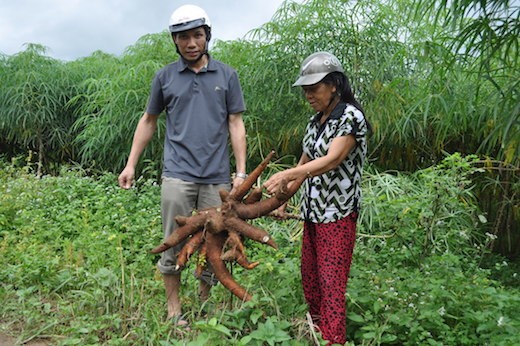A persistent problem in the Mekong is that misplaced and resettled river communities are unable to continue their original way of living. For example, they may lose access to cultivable land, grazing spaces for livestock, or fishing grounds, which can often mean losing an important source of income. How can new sustainable options be created for these communities?
 Villagers in Vietnam who took part in the pilot CPWF project look at their cassava crop. Photo: Olivier Joffre/WorldFish
Villagers in Vietnam who took part in the pilot CPWF project look at their cassava crop. Photo: Olivier Joffre/WorldFish“Pairing credible research results and good relations with private or government sectors can lead these sectors to support new options for resettled communities to enhance their livelihoods,” says Sonali Sellamuttu, Senior Researcher of Livelihood Systems at IWMI, based on findings from a Challenge Program on Water and Food (CPWF) project.
During a conference on hydropower in Asia this week, Sellamuttu talks about one successful example of how effective engagement with private and government sectors can bring positive impacts on communities affected by hydropower development. The project looked at how a new strain of cassava could help households who lost land to the Yali dam reservoir on the Sesan River in Kon Tum province, Vietnam.
The Yali hydropower dam, completed in 2003, displaced over 1,000 households and led to the loss of over 6,000 hectares of land, of which 30% had been agricultural.
The drawdown zone of the dam reservoir (the land which is exposed when the water level of the reservoir is dropped) covers about 2600 hectares. While part of this land was being used for cassava cultivation in 2012, planting in the area carried with it considerable risk; the sudden threat of flooding at the end of the growing season based on electricity demand could destroy many months of work.
CPWF’s national partner in Vietnam, the Soils and Fertilizer Research Institute (SFRI), conducted livelihood surveys around the Yali reservoir, which revealed the drawdown zone to be highly productive. As such, Vietnam’s Department of Agriculture and Rural Development (DARD) was very interested in improving cassava yield in the area.
In order to overcome the risk of flooding, the CPWF project in collaboration with SFRI and DARD established a livelihood pilot in the Sa Binh commune to cultivate a new short term variety of cassava in the drawdown area of the reservoir in 2012 and 2013.
The results of the pilot were dramatic: the new strain of cassava had a significantly higher yield and starch content compared to its predecessors, leading to an increase in net income per hectare of 82% in 2012 and almost 100% in 2013.
So what made this pilot so successful?
Nguyen Duy Phuong, Deputy of the Land Use Research Department of SFRI, who was a key member of the CPWF project team, believes that the close involvement of a government organization (DARD) made all the difference:
- DARD selected the households to participate in the project
- DARD worked with SFRI to conduct trainings for the farmers
- DARD regularly monitored the plots and communicated with the farmers to gain their feedback
- DARD facilitated a better system for communicating a calendar of water level in the reservoir between the local communities and the Yali Hydropower Company
DARD was even able to help the local communities in ways it may not have intended. Because the hydropower company needs to store water in the reservoir in order to have water to power the dam during the dry season, planting in the drawdown zone means that there is a very long break between harvest and planting. Therefore, additional cassava must be cultivated in the uplands in order to have stems to plant in the drawdown during the next planting season. Coordinating this kind of system can be rather complicated. However, due in part to the training and feedback provided by DARD, the farmers themselves were able to initiate the establishment of a network to regulate and monitor the process.
In light of the successful results of the pilot, district and commune authorities in the area are planning on scaling up the cultivation of this variety of cassava. DARD expects that by 2017, a significant portion of the planting area of the drawdown zone will be used exclusively for this purpose.
We often hear about the negative effects of hydropower development on resettled and riverside communities. While it is certainly a challenge for these households to find new livelihood activities, research like this shows that there are innovative and promising ways to improve livelihoods and mitigate the effects of hydropower resettlements on local communities. We can provide the evidence for why these approaches are effective and work together with private and government partners to make them successful and sustainable.
Sellamuttu is presenting at the International Conference on Water Resources and Hydropower Development in Asia (11-13 March, Colombo, Sri Lanka). View her presentation: Hydropower Development and Livelihoods: A Quest for a Balanced Approach through Research and Partnerships.














Comments
The title is a bit misleading. Mitigating some of the losses causes by displacement is a bit different from benefitting from hydropower. Yes, farmers have benefitted from a multi-stakeholder partnership that introduced new varieties, provided training, and developed a market chain, but that can be done with or without a dam.
A great outcome and well done to the team. Has the hydropower company bought into this approach and will it manage dam water levels to cater for the cassava crop established in the drawdown zone?